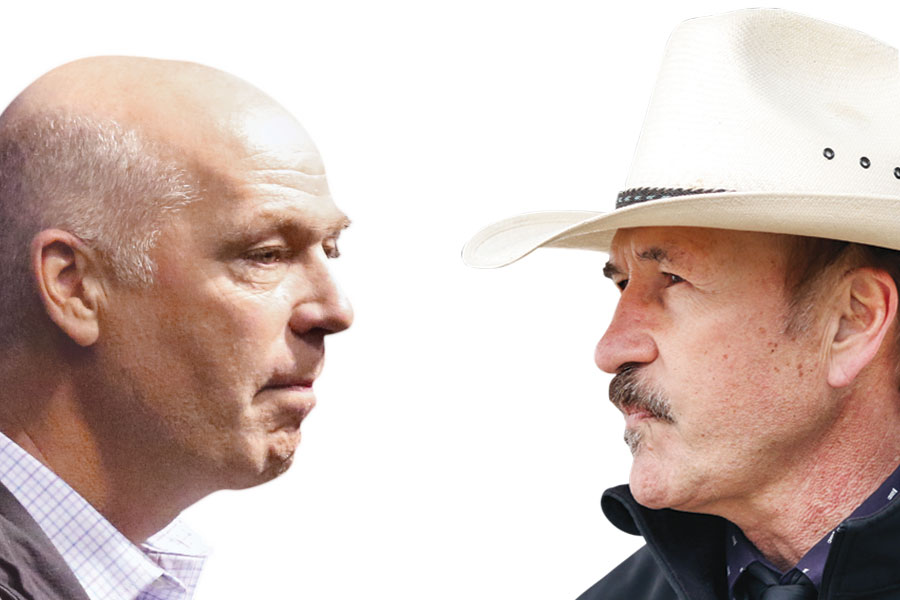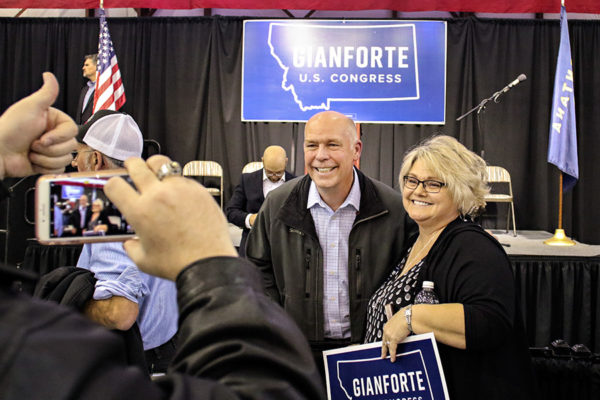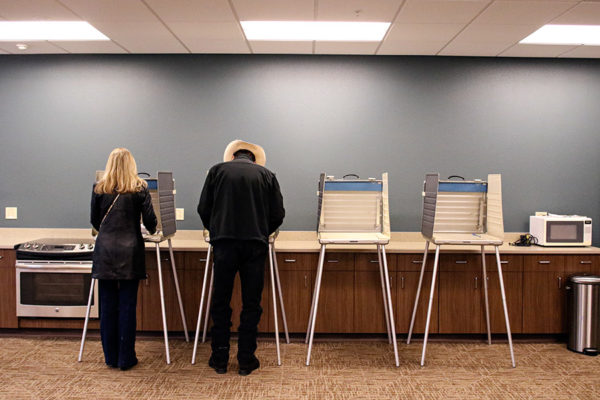All Eyes on Montana
With the Treasure State’s lone U.S. House seat up for grabs, the special election is intensifying as the candidates enter their final sprint and gain national attention
By Tristan Scott
With Montana’s at-large House seat in play, the state’s colorful congressional race is occupying a prominent spot on the national political stage as Democrats look to win back the influence the party has lost at the state and federal level in recent years.
Republicans, meanwhile, are eager to prove they haven’t lost momentum in rural states that overwhelmingly supported Donald Trump, despite the president’s low national approval ratings. Trump carried Montana by 21 points in November, but Democrats remain hopeful that an energized progressive base and an onslaught of grassroots activism will overwhelm an enthusiasm deficit and boost their turnout numbers in the special election.
The political appetite of Montana voters doesn’t necessarily align with the carte du jour dished out by traditional national punditry and horse-race analytics, and while the two main candidates are looking to gain traction with help from their national party’s campaign arms and healthy doses of celebrity boosterism, neither has emerged as a shoo-in to win the May 25 election.
The candidates are running to replace Republican Ryan Zinke, the Whitefish native who left Congress to become interior secretary under the Trump administration, thus leaving the state’s at-large seat vacant and setting a rare special election in motion.
Running for the Democrats is Rob Quist, a career musician and political newcomer from Creston who campaigns in a cowboy hat and bolo tie and peppers his stump speeches in folksy, dulcet aphorisms, often breaking out his guitar or banjo for a round of political sing-songing.
Quist has seized on a populist message that he hopes will appeal to a bloc of voters disenchanted with the status quo of Washington politics, and his energetic rallies have activated the state’s progressive base. He’s also earned endorsements from prominent Democrats, such as former Gov. Brian Schweitzer and U.S. Sen. Jon Tester, as well as a pledge from Independent Vermont Sen. Bernie Sanders to barnstorm the state with Quist in the final days leading up to the May 25 election.
“This is a chance to really make a statement and to really make a difference,” Quist said during a recent stop at the Flathead County election department, where he cast a vote for himself. “We’re not just seeing support from Democrats, but Independents and Republicans who recognize the need for change and progress. This is a grassroots campaign, and the number one thing is to come out and vote. I’m asking the state of Montana to turn out for Montana and turn out for me.”

Republicans have found their candidate in wealthy high-tech entrepreneur Greg Gianforte, a Bozeman businessman who had never run for elected office prior to last year’s unsuccessful bid to unseat Democratic Gov. Steve Bullock. Gianforte is employing President Trump’s mantra to “drain the swamp,” appearing at multiple campaign events with Donald Trump Jr., the president’s eldest son. He’s also scheduled upcoming campaign events with Vice President Mike Pence, and hitched his campaign message closely to Trump’s following the president’s success in Montana.
And while Quist’s campaign has attempted to portray Gianforte as an out-of-touch millionaire with unsavory investments in Russian financial firms that have been sanctioned by the U.S. and an aversion to public lands, the Republican has defended his financial background and remains firm in his commitment to Montana values like hunting and fishing.
In a recent interview with the Beacon, Gianforte flipped through a carousel of photos stored in his smartphone revealing the bounty of elk, deer and even a bobcat he shot last fall.
“I came to Montana largely for the public lands, and I spend as much time as possible hunting and fishing on its public lands,” Gianforte said, repeating his promise not to support federal land transfers. “We are not going to sell off public lands. I don’t know if I can be any more clear than that.”

Finally, Libertarian candidate Mark Wicks, a rancher from Inverness, rounds out the ballot, and although he’s not considered a contender to win the race, his strong performance at last month’s sole debate for the seat may earn him an uptick in support that could potentially shift the balance.
Rob Saldin, a political science professor at the University of Montana, said there is a potential for Wicks to siphon votes away from Gianforte and aid Quist, who will need to do more than simply set progressive voters in motion to succeed.
“A Libertarian candidate like Wicks would certainly be more likely to take votes away from a Republican candidate versus a Democrat, and so if we do see a Quist upset, you would probably be looking at a higher-than-expected turnout for Wicks,” Saldin said. “But Wicks isn’t going to win 10 percent of the vote, so the only way you see him in a position to spoil it is if the race is already very close.”
Although recent polls show Gianforte leading Quist by single-digit figures, and Republicans are broadcasting confidence about a lockdown on Montana’s at-large seat, there are still elements at play that could tip the scales in Quist’s favor, Saldin said.
Chief among them is the debate surrounding the Republicans’ beleaguered American Health Care Act, which the U.S. House of Representatives narrowly passed last week. Gianforte expressed skepticism about the previous iteration of the AHCA, which Republicans failed to move forward, comparing it to a “cake that hasn’t been fully baked.”
In a statement from a campaign spokesman, Gianforte said he wanted more information before he would say if he supported the current bill, despite a recent report in the Washington Post quoting him telling supporters in a recorded phone call that he was encouraged by the forward movement to “repeal and replace” the Affordable Care Act, or Obamacare.
Quist, meanwhile, has been vocal about his staunch support for a single-payer health care system and is critical of the GOP’s attempts to reduce health care access to Americans.
“This bill ends protections for people with preexisting conditions and would force older Americans to pay even more,” Quist said. “I oppose this bill because it would hurt the people of Montana and hardworking families across the state. No real Montanan would vote for it.”
![]()
As political newcomers, both Quist and Gianforte have employed their outsider status and their connection to voters as self-described “real Montanans” to distinguish themselves even though their politics are poles apart.
Gianforte would support taking away funding for Planned Parenthood, a nonprofit that provides reproductive health care to women, as well as some abortion services, while Quist called for an end to “the assault on women’s reproductive rights.”
“He’s standing with politicians who want to get in between women and their doctors,” Quist said of his opponent.
Almost from the outset, Quist has been criticized for an untidy financial history, including a 16-year trail of debt and a lawsuit over an unpaid loan and liens filed to collect delinquent taxes.
During the recent debate, Quist challenged Gianforte’s financial ties to Russia, pointing out that he owns shares in a pair of index funds that include companies under U.S. sanctions.
Gianforte dismissed the investments as composing a small fraction of his portfolio — about $250,000 — and Saldin predicted the charge probably won’t have a lot of teeth with voters.
“That initial week of information about Quist’s financial background really hurt him because that was at a time when people didn’t know a lot about him,” Saldin said. “At this point in the campaign as the candidates trade attacks, the stuff about Gianforte and Russia doesn’t quite pack the same punch. At this point, people have a pretty firm impression of him, and the new information isn’t likely to upend those impressions. I do think we have reached a point where the attacks are going to have diminishing returns.”
The flurry of attack ads from both candidates won’t end, however, as both parties continue to make contributions to the campaigns at the national level.
The Democratic Congressional Committee, which works to elect Democrats to the House, has spent about $600,000 to help fund television ads on Quist’s behalf and deploy get-out-the-vote campaigns. The Democratic National Committee has pledged to help drive volunteer fundraising efforts.
That pales in comparison to the GOP’s support of Gianforte, whose campaign has received more than $2.5 million in national party support.
Democrats have lost Montana’s previous 11 House races to Republicans, and have not held the seat since Pat Williams left office in 1997. Often, the party attempts to cull median voters by running a candidate who hugs the middle in a state whose politics is often characterized as “purple” and defined by individualism.
For Quist, an outpouring of grassroots support continues to buoy his spirits, and he pointed to the more than $2.5 million in contributions as evidence that his message has struck a chord with voters. The majority of those small donors contribute just $29, he said.

Even as Democrats try to prove they can win in places that aren’t liberal strongholds, the party’s overarching anti-Trump message may alienate states like Montana, where voters overwhelmingly approve of the president.
Best known for forming the Mission Mountain Wood Band in 1971 in Missoula, Quist recently enjoyed support from actress Alyssa Milano, who rode around in a van shuttling students to a polling station at the Missoula County Fairgrounds in hopes of capitalizing on their votes.
But classes are winding down at the University of Montana, and students with liberal tendencies will begin scattering before the May 25 special election concludes.
The timing of the special election also presents problems that could reduce voter turnout, Saldin said, coming on a Thursday before Memorial Day weekend.
“At this point, both candidates are hoping people will vote as early as possible, but it is probably a bigger concern for Quist,” he said.

Flathead County Election Administrator Monica Eisenzimmer said a steady trickle of voters have been showing up at the election department to cast their ballots, while absentee ballots mailed out last week have arrived.
At this point in the unusual election cycle, Saldin said it’s unlikely that many voters are undecided, and both candidates will be raising enthusiasm to generate interest in the final two weeks.
While Democrats haven’t managed to outright win any other special elections to replace Republican lawmakers selected to serve in the Trump administration’s cabinet, the races in right-leaning states have been closer than expected, Saldin said, which could fuel progressive turnout in Montana.
“Usually the unfortunate timing of this election would suggest a lower turnout, and that traditionally is bad news for Democrats who do better when turnout is high,” Saldin said. “The question is, ‘Can their enthusiasm and engagement right now overcome that?’ And from what we have seen elsewhere, it is not unreasonable to think that it might.”